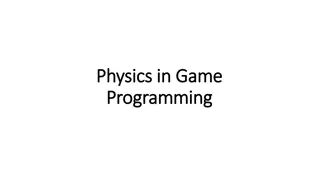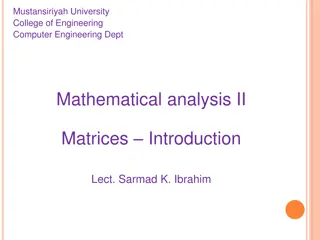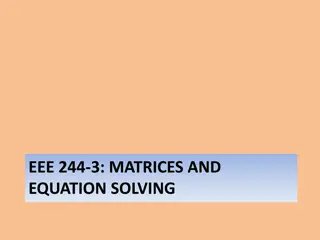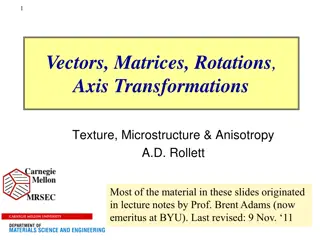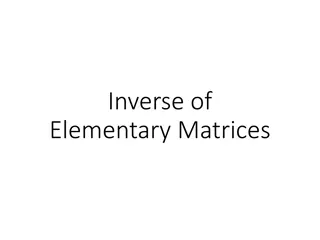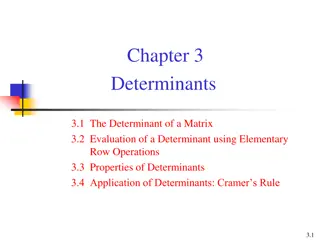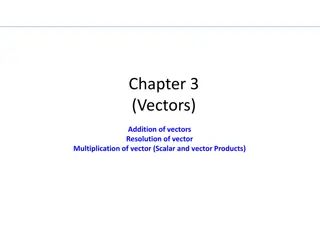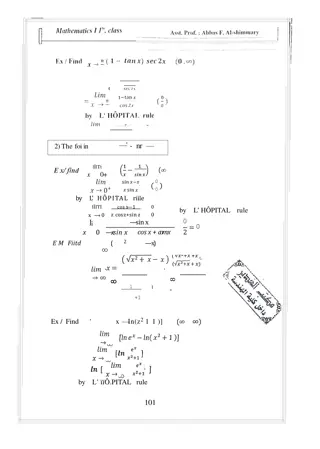
Vectors and Matrices in Linear Algebra Theory
Explore the concepts of vectors, matrices, and linear transformations in linear algebra theory. Discover how numbers are crucial in computer data representation and learn about vector addition, multiplication, and their applications. Uncover the relationship between vectors and numbers through a series of basic operations. Understand the significance of coordinate systems and basis vectors in representing vectors in multidimensional space.
Download Presentation

Please find below an Image/Link to download the presentation.
The content on the website is provided AS IS for your information and personal use only. It may not be sold, licensed, or shared on other websites without obtaining consent from the author. If you encounter any issues during the download, it is possible that the publisher has removed the file from their server.
You are allowed to download the files provided on this website for personal or commercial use, subject to the condition that they are used lawfully. All files are the property of their respective owners.
The content on the website is provided AS IS for your information and personal use only. It may not be sold, licensed, or shared on other websites without obtaining consent from the author.
E N D
Presentation Transcript
CS246: Vectors and Matrices Junghoo John Cho UCLA
Understanding Numbers We know numbers. We feel comfortable with dealing with them. We know their relationship Q: What is 2? What is ? What is their relationship? When we deal with data on a computer, we deal with a whole bunch of numbers Images, sounds, videos, text At the end of the day there are nothing but numbers in computers! Q: Do you feel comfortable a sequence of numbers? Do you understand them like you understand a single number? Q: [0.032, 0.184, 0.163, 0.132]. What does it mean? Q: What does multiplying two list of numbers mean?
Linear Algebra Theory of vectors and their linear transformation As it turns out, linear algebra helps us build insights on a whole bunch of numbers and their relationship Incidentally, almost all algorithms consist of a sequence of basic linear algebraic operations; matrix addition, multiplication, exponentiation Let us start with reviewing the notion of vector
What is a vector? 4 An arrow in an ?-dimensional space 5 3 Once we choose the coordinate system (= basis vectors), a vector can be represented as a sequence of ? numbers (3, 5, 4) 1-to-1 correspondence between vectors isomorphic: they may look different but they are really the same thing The first connection between linear algebra and a set of numbers sequence of ? numbers
Vector Addition ? + ? Vector addition in number representation: ? = 1,2,0 , ? = 2,1,1 ? + ? = 1 + 2, 2 + 1, 0 + 1 = (3,3,1) Component-wise addition ? ?
Vector Multiplication Scalar multiplication: ? ?? Stretch the vector 3 ? = 3 ? Scalar multiplication in number representation ? = 1,2,1 3 ? = 3 1,2,1 = 3 1, 3 2, 3 1 = (3,6,3) Multiply the number to every component Dot product: ? ? ? 3 ? ? ? = ? ? cos? Dot product in number representation ? = 1,2,0 , ? = 2,1,1 ? ? = 1 2 + 2 1 + 0 1 = 4 Component-wise multiplication ? ? ?
Trick Question Q: (1, 0) vs (0, 1). Are they the same vectors? A: It depends on the choice of coordinate systems (=basis vectors) Choice of basis vectors determines vector interpretation of a sequence of numbers
Change of Coordinates (1) (0, 1) ?2 1 2 , 1 ( 2) Two coordinate systems (1, 0), (0, 1) (1 2), ( Q: What is the number representation of ?1= (2,0) under the second coordinate system? A: ( 2, 2) Q: What is the number representation of ?2= (1,1) under the second coordinate system? A: ( 2,0) (1 2 , 1 2) 2 , 1 1 2 , 1 2) ?1 (1, 0)
Change of Coordinates (2) Q: In general, how can we compute new coordinates of a vector under different basis vectors? To discuss it, we first take a detour on a matrix and its operations
What is a Matrix? Two-dimensional array of numbers 3 1 8 5 1 2 4 6 7 Another example of a whole bunch of numbers Matrix as a list of vectors List of row vectors 3,1,8 , 5,1,2 , 4,6,7 List of column vectors 3 5 4 6 7 ?1 ?2 ?3 1 1 8 2 | | | , , ?1 | ?2 | ?3 |
Matrix-Vector Multiplication: ? ? Definition: 3 2 4 1 1 5 1 3 2 3 5 4 3 3 + 1 5 + 1 4 2 3 + 1 5 + 3 4 4 3 + 5 5 + 2 4 A ? = = Q: What does this multiplication mean? | | | ?1 ?2 ?3 | | | ?3 ?1 ?2 | | | = ?1 ?1+ | ?2 ?2 | ?3 ?3 |
Matrix Multiplication: ?? Definition: 3 2 4 1 1 5 1 3 2 3 5 4 1 1 6 8 2 7 AB = 3 3 + 1 5 + 1 4 2 3 + 1 5 + 3 4 4 3 + 5 5 + 2 4 Q: What does a matrix multiplication mean? 3 1 + 1 1 + 1 6 2 1 + 1 1 + 3 6 4 1 + 5 1 + 2 6 3 8 + 1 2 + 1 7 2 8 + 1 2 + 3 7 4 8 + 5 2 + 2 7 =
Matrix Multiplication: Vector Array View ?11 ?1 + ?12 ?2 + ?13( ?3 ) ?1 ?2 ?3 ?1 ?2 ?3 = ?21 ?1 + ?22 ?2 + ?23( ?3 ) 3 2 4 1 1 5 1 3 2 3 5 4 1 1 6 8 2 7 ?31 ?1 + ?32 ?2 + ?33( ?3 ) | | | ?1 ?2 ?3 3 3 + 1 5 + 1 4 2 3 + 1 5 + 3 4 4 3 + 5 5 + 2 4 3 1 + 1 1 + 1 6 2 1 + 1 1 + 3 6 4 1 + 5 1 + 2 6 3 8 + 1 2 + 1 7 2 8 + 1 2 + 3 7 4 8 + 5 2 + 2 7 = ?1 | ?2 | ?3 | = ???= ?? ?? ?1 ?2 ?3 ?1 ?2 ?3 | | | | | | ?1 | ?2 | ?3 | = + + ?1 | ?2 | ?3 | | | | | | | | | | | | | | | | = ?11 + ?12 + ?13 ?3 | ?21 + ?22 + ?23 ?3 | ?31 + ?32 + ?33 ?3 | ?1 | ?2 | ?1 | ?2 | ?1 | ?2 | ?1 | ?2 | ?3 | ?1 | ?2 | ?3 |
Multiplying Multiple Vectors Together If we want to multiply matrix ? with many vectors ?1, ?2, ?? we can simply multiply ?with a matrix with columns of ?? s : | | | | | | ? = ?1 | ?2 | ?? | ?1 | ?2 | ?? | During matrix multiplication, columns of the second matrix are independent of each other Rows of the first matrix are also independent of each other as well
Back to Change of Coordinates Q: In general, how can we compute new coordinates of a vector under different basis vectors? (0, 1) 1 2 , 1 ( 2) (1 2 , 1 2) (1,0),(0,1) ? ? ? ? ?, , ?, ? ? (2,0) ( 2, 2) (1, 0) (1,1) ( 2,0)
Matrix for Change of Coordinates We get the new coordinates of a vector under new basis vectors ?1,?2, , ??by multiplying the original coordinates with the following matrix ? ?1 ?? ??= ? First special meaning that we give to a particular class of matrices Some matrices represent change of coordinates
Matrix for Change of Coordinates: Example (1,0),(0,1) ? ? ? ? ?, , ?, ? ? (2,0) ( 2, 2) (1,1) ( 2,0) ? ? 2 0 1 1 2 2 ? ? = ? ? 2 0 ? ?
Matrix: Change of Coordinates Q: What does change of coordinate matrix look like? How can we recognize it? ? ?1 ?? ??= ? Q: What are the properties of basis vectors, ?? s? A: ?? ??= 1 if ? = ? 0 if ? ? Q: What will be ???? A: ??? = ?
Change of Coordinates: Orthonormal Matrix Orthonormal Matrix: definition ??? = ? Q: Given a matrix ?, how can we check if it is orthonormal? Matrix for change of coordinates orthonormal matrix Q: If ? is an orthonormal matrix, can we consider it as a matrix for change of coordinates? Q: What will be the basis vectors for the new coordinates? Matrix for change of coordinates orthonormal matrix ??? = ?





